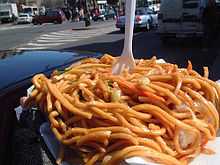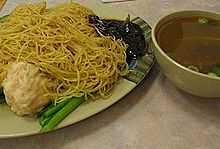Lo mein
| Lo mein | |||||||||||||
 American-Chinese-style Lo mein
 Cantonese style lo mein | |||||||||||||
| Simplified Chinese | 捞面 | ||||||||||||
|---|---|---|---|---|---|---|---|---|---|---|---|---|---|
| Traditional Chinese | 撈麵 | ||||||||||||
| Cantonese Jyutping | lou1 min6 | ||||||||||||
| Literal meaning | mixed/stirred noodles | ||||||||||||
| |||||||||||||
| Alternative Chinese name | |||||||||||||
| Simplified Chinese | 拌面 | ||||||||||||
| Traditional Chinese | 拌麵 | ||||||||||||
| Cantonese Jyutping | bun6 min6 | ||||||||||||
| |||||||||||||
Lo mein (Chinese: 撈麵) is a Chinese dish with wheat flour noodles. It often contains vegetables and some type of meat or seafood, usually beef, chicken, pork, shrimp or wontons.
Traditionally this is a variation of wonton noodle soup. The soup is simply separated from the noodles and other ingredients, and served on the side.
Etymology
The term lo mein comes from the Cantonese lōu mihn (撈麵), meaning “stirred noodles”.[1] The Cantonese usage of the character 撈, pronounced lōu and meaning "to stir", differs from the character's usual meaning of "to dredge" or "to scoop out of water" in Mandarin, in which case it would be pronounced as làauh or lòuh in Cantonese (lāo in Mandarin).[2][3] In Mandarin, the dish is more typically called bàn miàn (拌麵), not to be confused with bǎn miàn (板麵).
American Chinese cuisine
In American Chinese restaurants, lo mein is a popular take-out food. In this setting, lo mein noodles are usually stirred with a sauce made from soy sauce and other seasonings. Vegetables such as bok choy and cabbage can be mixed in and meats like roast pork, beef or chicken are often added. Shrimp lo mein, lobster lo mein, vegetable lo mein, and "House" lo mein (more than one meat) are sometimes available.
A version sold in many places in western North America is sometimes labeled as chow mein. However, the two are prepared differently, with very different noodles. Chow mein is stir fried, while lo mein is not.[4]
Gallery
-
American Style Lo Mein
See also
References
- ↑ "lo mein". Merriam-Webster Online Dictionary. Merriam-Webster Online. 2008
- ↑ "撈". 《現代標準漢語與粵語對照資料庫》 (A Comparative Study of Modern Chinese and Cantonese) (in Chinese). 香港中文大學 (Chinese University of Hong Kong).
- ↑ "撈". 《粵語審音配詞字庫》 (Chinese Character Database: With Word-formations Phonologically Disambiguated According to the Cantonese Dialect) (in Chinese). 香港中文大學 (Chinese University of Hong Kong).
- ↑ http://feastasia.casaveneracion.com/lo-mein-not-chow-mein/
| ||||||||||||||||||||||||||||||||||||||||||
| ||||||||||||||||||||||||||
